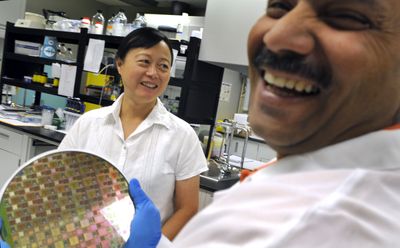UI team pursues E. coli detection
Groundbreaking technology could save lives, money

A team of University of Idaho scientists in Post Falls is working on groundbreaking nanotechnology to quickly detect E. coli in hamburger, research that is gaining national attention and the notice of peers at universities such as Harvard.
When completed, a sensor – basically a microchip smaller than a postage stamp – will be able to detect almost any type of bacteria, from the antibiotic-resistant staphylococcus aureus to a biomarker for lung cancer.
Ultimately, the technology will result in faster and more accurate pathogen detection, saving lives and reducing health care costs, said principal investigator Wusi Maki, of the Center for Advanced Microelectronics and Biomolecular Research.
“If we make something quicker and easier to (use) then there will be fewer outbreaks,” Maki said as teammate Nirankar Mishra showed samples of the shiny chips in the lab at the UI Research Park.
USDA testers will put a sample – such as a drop of water or a pinch of hamburger – on the device. The device will plug into a laptop, and contamination results will pop up on the screen. Once the device is mass-produced, likely in several years, Maki expects it to be inexpensive and easy to use, even for people without science backgrounds.
But the work’s not done. The group still is trying to finalize and prove the technology.
The project, which went public a year ago, is gaining recognition, especially with the recent outbreaks of E. coli and salmonella and concerns by consumer advocates who say the federal government has been sluggish about detection, prevention and response to outbreaks.
Just this month, Fred Meyer’s parent company announced a recall of ground beef sold in all of its stores in Washington and Idaho because of possible E. coli contamination. Nearly 1,300 people have been sickened in a salmonella outbreak. The four-member team, which also includes Eric Cameron and Brian Filanoski, brings together scientists with biology, chemistry and electronics expertise.
“This way we can put our brains together,” Maki said.
Filanoski, a Spokane native, deals with the living proteins and DNA while Maki works out how to get the microchip to capture the signal from the sample. Mishra makes the chips while Cameron tests the device’s sensitivity.
Before the CAMBR team got together, most similar research in the country focused on the sensor. This group can work on the sensor and the electronic microchip, which is key to the success.
Once the technology is ready, the group will give it to the USDA to use and test. If approved, the device will be manufactured and put on the market.
The team gave a tour in June to members of the the Idaho Legislature’s Joint Finance Appropriations Committee.
The thought of instantly detecting E. coli, and not waiting nearly a week for cultures to grow in a lab, made the lawmakers “ooh” and “ahhh.” Most were surprised such groundbreaking work was happening in North Idaho, several hours from the main Moscow campus.
Post Falls Rep. Frank Henderson hopes the probe is manufactured here if the research is successful.
“The commercial opportunity is in the millions,” he said.
Henderson said he had confidence in the researchers but understood a snag could halt the project any day.
“That’s what research is,” he said. “It’s like Las Vegas.”
The team jokes that it’s difficult for scientists from Ivy League universities to always take a group of researchers from North Idaho seriously.
“They’re surprised we have all our teeth,” Filanoski said with a laugh.